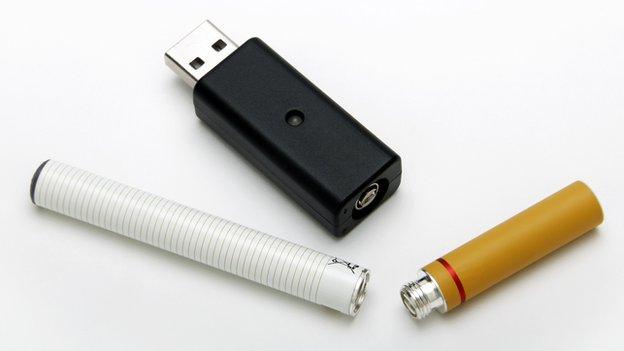The e-cigarettes phenomenon
- Published
The use of e-cigarettes has surged since smoking bans came into place.
In the UK, there are an estimated 1.3m users, compared with 9m smokers.

But what exactly are e-cigarettes?

E-cigarettes come in two parts: in one end there is liquid nicotine, and in the other a rechargeable battery and an atomiser.
When the user sucks, the liquid nicotine is vaporised and absorbed through the mouth.
What looks like smoke is largely water vapour, hence smoking e-cigarettes is often called vaping.
As the e-cigarettes contain nicotine, the user gets the hit that makes smoking addictive, without being harmed by the toxins found in real cigarettes.

So are they safe, then?

The British Medical Association says the simple answer is that we don't yet know, pointing out that only long-term research can determine that.
The Medicines and Healthcare Products Regulatory Agency will regulate e-cigarettes as medicines from 2016.
Part of the reasoning for this move was that there was concern the e-cigarettes currently on the market did not meet appropriate standards of safety, quality and efficacy.
The regulator has said "levels of contamination" have been found in some products and others have been poorly manufactured.
However, there is a consensus that they are certainly less harmful than smoking tobacco, which is responsible for 100,000 deaths a year in the UK.

Should smokers use them to quit?

They are not recommended by the NHS yet, but there is some evidence they may help.
A team at the University of Auckland, in New Zealand, last year released the results of the first clinical trial comparing the devices with nicotine patches.
The results, published in the Lancet, showed 7.3% using e-cigarettes had quit after six months compared with 5.8% using patches.
What is more, after six months, 57% of e-cigarette users had halved the number of cigarettes smoked each day compared with 41% among those using patches.
However, the study did not involve enough people - just 657 - to prove definitively which is the better option.
There are also concerns that the increase in popularity of e-cigarettes could act as a gateway to smoking, particularly for young people.
The Local Government Association has been critical of the way they appear to be marketed at children through social media and the sale of fruit-flavoured versions.

Are they not covered by legislation?

Not a great deal. The UK - like many countries - is playing catch up.
Earlier this year ministers in England said they would ban the sale of e-cigarettes to under 18s. Similar legislation is being considered elsewhere in the UK.
Wales is also considering a proposal to ban the use of them in public places - to mirror the law covering real cigarettes. Some companies, including train firms, airlines and the pub chain JD Wetherspoon, have taken the step themselves.
Other countries have gone even further. Brazil, Singapore and Mexico have banned importing and selling the devices, even though tobacco is still on sale in all those countries.